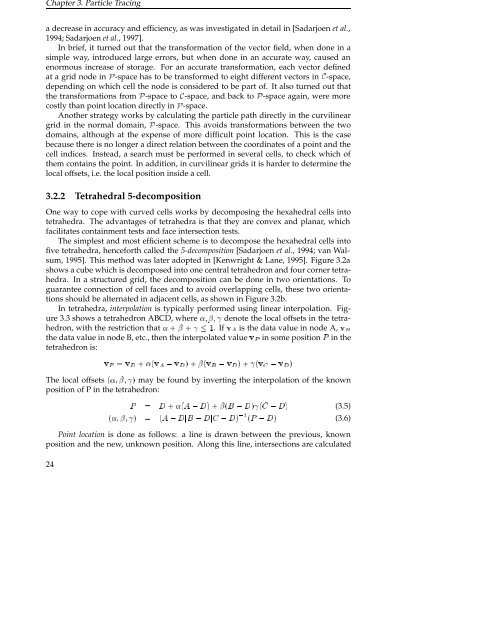Chapter 4 Vortex detection - Computer Graphics and Visualization
Chapter 4 Vortex detection - Computer Graphics and Visualization
Chapter 4 Vortex detection - Computer Graphics and Visualization
You also want an ePaper? Increase the reach of your titles
YUMPU automatically turns print PDFs into web optimized ePapers that Google loves.
<strong>Chapter</strong> 3. Particle Tracing<br />
a decrease in accuracy <strong>and</strong> efficiency, as was investigated in detail in [Sadarjoen et al.,<br />
1994; Sadarjoen et al., 1997].<br />
In brief, it turned out that the transformation of the vector field, when done in a<br />
simple way, introduced large errors, but when done in an accurate way, caused an<br />
enormous increase of storage. For an accurate transformation, each vector defined<br />
at a grid node in È-space has to be transformed to eight different vectors in -space,<br />
depending on which cell the node is considered to be part of. It also turned out that<br />
the transformations from È-space to -space, <strong>and</strong> back to È-space again, were more<br />
costly than point location directly in È-space.<br />
Another strategy works by calculating the particle path directly in the curvilinear<br />
grid in the normal domain, È-space. This avoids transformations between the two<br />
domains, although at the expense of more difficult point location. This is the case<br />
because there is no longer a direct relation between the coordinates of a point <strong>and</strong> the<br />
cell indices. Instead, a search must be performed in several cells, to check which of<br />
them contains the point. In addition, in curvilinear grids it is harder to determine the<br />
local offsets, i.e. the local position inside a cell.<br />
3.2.2 Tetrahedral 5-decomposition<br />
One way to cope with curved cells works by decomposing the hexahedral cells into<br />
tetrahedra. The advantages of tetrahedra is that they are convex <strong>and</strong> planar, which<br />
facilitates containment tests <strong>and</strong> face intersection tests.<br />
The simplest <strong>and</strong> most efficient scheme is to decompose the hexahedral cells into<br />
five tetrahedra, henceforth called the 5-decomposition [Sadarjoen et al., 1994; van Walsum,<br />
1995]. This method was later adopted in [Kenwright & Lane, 1995]. Figure 3.2a<br />
shows a cube which is decomposed into one central tetrahedron <strong>and</strong> four corner tetrahedra.<br />
In a structured grid, the decomposition can be done in two orientations. To<br />
guarantee connection of cell faces <strong>and</strong> to avoid overlapping cells, these two orientations<br />
should be alternated in adjacent cells, as shown in Figure 3.2b.<br />
In tetrahedra, interpolation is typically performed using linear interpolation. Figure<br />
3.3 shows a tetrahedron ABCD, where « ¬ denote the local offsets in the tetrahedron,<br />
with the restriction that « ¬ .IfÚ is the data value in node A, Ú<br />
the data value in node B, etc., then the interpolated value ÚÈ in some position È in the<br />
tetrahedron is:<br />
ÚÈ Ú « Ú Ú ¬ Ú Ú Ú Ú<br />
The local offsets « ¬ may be found by inverting the interpolation of the known<br />
position of P in the tetrahedron:<br />
È « ¬ (3.5)<br />
« ¬ È (3.6)<br />
Point location is done as follows: a line is drawn between the previous, known<br />
position <strong>and</strong> the new, unknown position. Along this line, intersections are calculated<br />
24

















